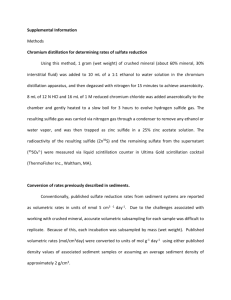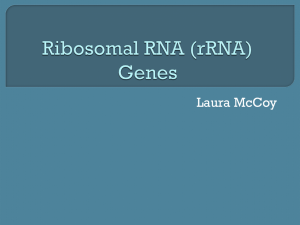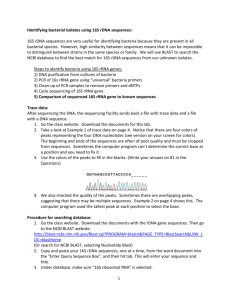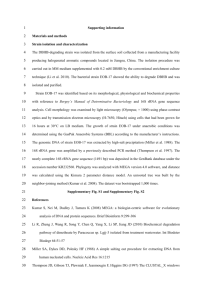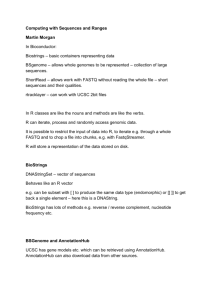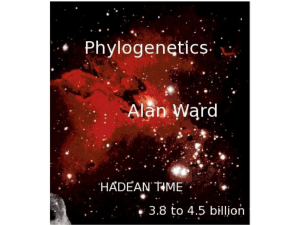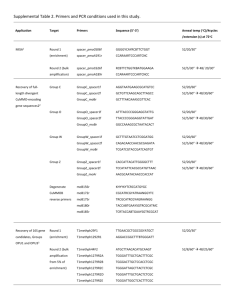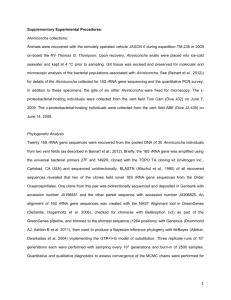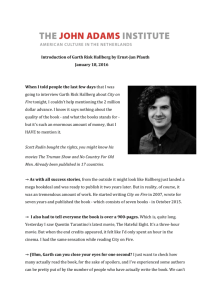emi412351-sup-0001-si
advertisement
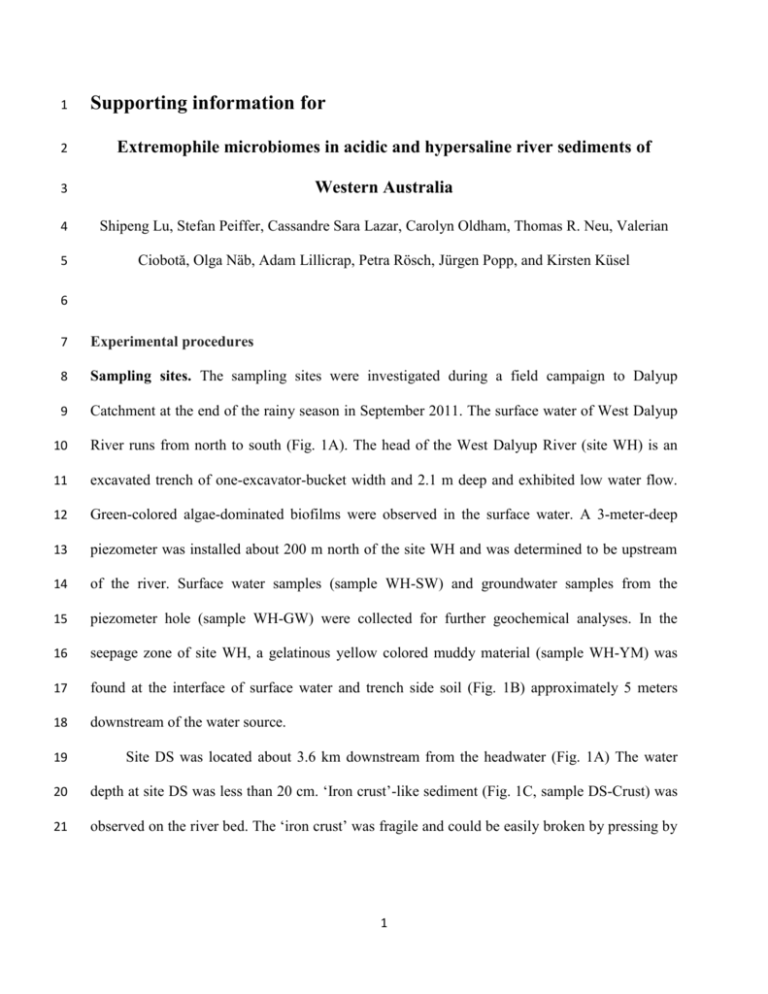
1 Supporting information for 2 Extremophile microbiomes in acidic and hypersaline river sediments of 3 Western Australia 4 Shipeng Lu, Stefan Peiffer, Cassandre Sara Lazar, Carolyn Oldham, Thomas R. Neu, Valerian 5 Ciobotă, Olga Näb, Adam Lillicrap, Petra Rösch, Jürgen Popp, and Kirsten Küsel 6 7 Experimental procedures 8 Sampling sites. The sampling sites were investigated during a field campaign to Dalyup 9 Catchment at the end of the rainy season in September 2011. The surface water of West Dalyup 10 River runs from north to south (Fig. 1A). The head of the West Dalyup River (site WH) is an 11 excavated trench of one-excavator-bucket width and 2.1 m deep and exhibited low water flow. 12 Green-colored algae-dominated biofilms were observed in the surface water. A 3-meter-deep 13 piezometer was installed about 200 m north of the site WH and was determined to be upstream 14 of the river. Surface water samples (sample WH-SW) and groundwater samples from the 15 piezometer hole (sample WH-GW) were collected for further geochemical analyses. In the 16 seepage zone of site WH, a gelatinous yellow colored muddy material (sample WH-YM) was 17 found at the interface of surface water and trench side soil (Fig. 1B) approximately 5 meters 18 downstream of the water source. 19 Site DS was located about 3.6 km downstream from the headwater (Fig. 1A) The water 20 depth at site DS was less than 20 cm. ‘Iron crust’-like sediment (Fig. 1C, sample DS-Crust) was 21 observed on the river bed. The ‘iron crust’ was fragile and could be easily broken by pressing by 1 22 hand. The ‘iron-crust’ was visually apparent from the sampling point to approximately one 23 hundred meters downstream. 24 For further chemical analyses all the water samples were filtered (0.45 μm), acidified if 25 required (1vol-‰ 1M HNO3) and stored at low temperature (~ 4 °C). Water samples for isotopic 26 analyses were filled in dark glass bottles (30 ml) without headspace and sealed with gas-tight 27 screw caps. Fresh sediment samples were wrapped into two to three layers of zip-lock 28 polyethylene bags and stored at ~ 4 °C for mineralogical analyses. Samples for molecular 29 biological analyses were mixed with All-protect Tissue Reagent (Qiagen) in the field and stored 30 frozen in the lab until processed. 31 Geochemical characterization of the water samples. The pH and electrical conductivity 32 of all the water and soil samples were measured on site with a pH/Cond 340i set (WTW). Metals, 33 metalloids, cations and anions in water samples were analyzed using inductively coupled plasma 34 optical emission spectrometry (ICP-OES) (Optima 3800XL; Perkin Elmer). Chloride anion and 35 dissolved organic carbon (DOC) were measured by a commercial laboratory having experience 36 with high salinity samples (ChemCentre, Australia). Fe(II) and total dissolved iron were 37 determined in the acidic supernatant using the phenanthroline method (Tamura et al., 1974). 38 Geochemical characterization, mineralogy and chemical composition analyses of the 39 sediment samples. Soil pH and conductivity were determined in a slurry with a 1:5 ratio of soil : 40 deionized water (Rayment and Higginson, 1992). Metals, metalloids, cations and anions were 41 analyzed using either ICP-OES or ICP-MS. Dissolved sulfate concentration in sediments was 42 measured using Barium-Chloride-Method (Tabatabai, 1974). Mineral phase examinations of 43 samples WH-YM and DS-Crust were performed using Raman spectroscopy. The measurements 44 were carried out with a commercial micro-Raman setup (HR LabRam inverse system, Jobin 2 45 Yvon Horiba) using 532 nm radiation from a frequency doubled neodymium-yttrium-aluminum 46 garnet laser. The laser beam of about 20 μW was focused on the samples by a Zeiss LD EC 47 Epiplan-Neofluar 100X (numerical aperture, [NA] 0.75) microscope objective down to a spot 48 diameter of approximately 0.7 μm. The spectral resolution was around 8 cm-1 and the acquisition 49 time for each Raman spectrum varied between 30 and 300 s. 50 The quantitative elemental composition was determined using x-ray fluorescence (XRF) in 51 the Institute of Environmental Geology, Technical University of Braunschweig. Mineral phases 52 were identified by powder X-ray diffraction using a D 5000 diffractometer (Siemens) equipped 53 with a Co anode (Co Kα radiation). The diffraction patterns were measured in a range of 10-90° 54 2θ and a step width of 0.02° 2θ (10sec/ step). The software DIFFRAC.SUITE (Bruker AXS 55 GmbH) was used for the interpretation of diffractograms. 56 The reactive and pedogenic iron in sample WH-YM were analyzed. For reactive iron 57 measurement, 0.5 g of dried sample was transferred into 50-ml polyethylene vials containing 50 58 ml 1M HCl (Wallmann et al., 1993; Kappler et al., 2004), followed by shaking at room 59 temperature for 24 h. Fe(II) and total dissolved iron were determined in the acidic supernatant 60 using the phenanthroline method. For extraction and determination of free pedogenic iron oxides, 61 the reductive dissolution with Na-dithionite was used (Mehra and Jackson, 1960). The sample 62 was dried and ground prior to analysis to reduce the particle size and increase the dissolution 63 efficiency. Fe concentrations were analyzed using atom absorption spectrometry. 64 Total DNA extraction and microbial community analyses. About 0.5 g wet material 65 was used for each DNA extraction (Lueders et al., 2004) from sediment samples WH-YM and 66 DS-Crust in triplicate. Retrieved DNA concentrations were determined by NanoDrop (Thermo 67 Fisher Scientific, USA) and the DNA samples were sent for 16S rRNA gene pyrosequencing 3 68 using 454 GS FLX+ platform (Research and Testing Laboratory, Texas, USA). The primer set 69 28F and 519R was used to amplify the bacterial V1–V3 hypervariable regions, and primer set 70 341F and 958R was used for archaeal V3-V5 regions (Suchodolski et al., 2009). The retrieved 71 raw sequences were analyzed using Mothur (Schloss et al., 2009). Briefly, raw sequences were 72 removed if they did not perfectly match the primer/barcode or were < 250 nt in length. Unique 73 sequences from all samples were merged, chopped to achieve the same length. Then the 74 sequences were aligned to the Silva reference alignment (Pruesse et al., 2007) as provided on the 75 Mothur platform. The aligned sequences were preclustered and chimeras were removed using the 76 Uchime algorithm implemented in Mothur. All remaining sequences were clustered into 77 operational taxonomic units (OTU) at 0.03 and 0.10 distance cut-offs. The archaeal taxonomy 78 was additionally checked and modified when necessary, by analysis of representative sequences 79 for each OTU groups. This was carried out by aligning the representative OTU sequences using 80 the SILVA web aligner (Pruesse et al., 2012) with reference 16S rRNA gene sequences of 81 previously defined uncultured archaeal groups, and then constructing a phylogenetic tree in ARB 82 (Ludwig et al., 2004). The percentage of coverage was calculated with the formula (1-[n/N] × 83 100, where n is the number of unique phylotypes and N is the total number of phylotypes. Both n 84 and N values were obtained from Mothur. 85 To obtain nearly-full length 16S rRNA gene sequences of the dominant phylogenetic 86 groups for further analyses, an additional bacterial 16S rRNA gene clone library of sample DS- 87 Crust was constructed using primers 27F and 1492R (Lane, 1991) as described previously (Lu et 88 al., 2010). The phylogenetic analyses were conducted using Mega Ver4.0 and Neighbor-Joining 89 method (Tamura et al., 2007). 4 90 Quantitative PCR (qPCR) analyses. qPCR analyses of sediment samples WH-YM and 91 DS-Crust were performed using 16S rRNA gene-specific primer sets for domains Bacteria and 92 Archaea, genera Acidiphilium, Acidocella, Ferrovum and Acidimicrobium (Supporting 93 information Table S1). The Acidocella-specific forward primer (Acido-LS-638, 5’- 94 CTCTAGCTCACACGTATC-3’) was designed in this study and its specificity was verified using 95 various online probe-match databases (Cole et al., 2009; Quast et al., 2013). Verifications were 96 done by PCR with plasmids containing cloned PCR product, DNA from closely related strains, 97 such as YE4-N1-5-CH (FN870350) from an acidic mine lake (Lu et al., 2010) and PFBC-3 98 (KC590088) (Jones et al., 2013), and various environmental DNA extracts. An aliquot of 10-50 99 ng of DNA extracts were used as templates for amplification with the Maxima SYBR Green 100 qPCR Mastermix kit (Fermentas, Canada). Thermo-cyclings were performed with Mx3000P 101 real-time PCR system (Stratagene, USA). Plasmids containing environmental clone sequences 102 were used as standards. Acquisition of fluorescence data was performed at the end of each cycle. 103 Dissociation curve analysis was performed to check the specificity of the qPCR products. 104 Standard curves were linear from 5 × 102 to 5 × 108 gene copies per reaction. The amplification 105 efficiency of Acidocella assay was 89% and the R2 value of the correlation curve was 1.000. 106 Isolation of acidophilic bacteria. Six gram of the sample WH-YM was diluted with 2 ml 107 0.7% (w/v) NaCl and homogenized by vortexing for 3 hours at ~1,000 rpm (Vortex-Genie 2 108 shaker, Scientific Industries, United States). The sample was subsequently diluted ten-fold with 109 0.7% (w/v) NaCl and 100 µl of the un-diluted and diluted samples were plated on each of the six 110 kinds of selective solid overlay media used for autotrophic and heterotrophic acidophilic 111 microorganisms (Johnson and Hallberg, 2007; Lu et al., 2010), including the yeast extract media 112 with pH of 3 (YE3) and 4 (YE4) and other four high Fe(II) containing media (Lu et al., 2010). 5 113 The plates were incubated at room temperature (~20 oC) in the dark and checked daily. Colonies 114 appearing on the plates were observed and photographed using a stereo microscope (Olympus 115 SZX10, Japan) and cell morphologies were examined under the brightfield-view of a microscope 116 (Axioplan, Carl Zeiss, Germany). The picked colonies were transferred to freshly made media 117 for at least five times and the cell morphology was monitored by microscopic examination. The 118 obtained 16S rRNA gene sequences were searched against the online database BLAST (Johnson 119 et al., 2008) to decide on their phylogenetic affiliations. 120 Growth test of bacterial isolates in NaCl containing medium. One of the isolates 121 (AusYE3-1) was tested for the aerobic growth in YE3 liquid medium (Johnson and Hallberg, 122 2007). The YE3 liquid medium was a complex medium which contained 100 µM ferrous 123 sulphate, 2% yeast extract and 10 mM fructose as carbon source and the final pH was adjusted to 124 3. NaCl was added into the YE3 medium at concentrations of 1.5%, 3%, 4.5%, 6% and 7.5% 125 NaCl (equal to 0.26, 0.51, 0.77, 1.03 and 1.28 M NaCl). The isolate cultures were incubated at 126 15 °C or 30 °C, and the optical density was measured at 600 nm wavelength. Triplicates of each 127 treatment were prepared and the growth tests were repeated three times. In addition, the isolate 128 was tested for its anaerobic growth and ferric reduction capacity in YE3 medium with or without 129 3% NaCl, 10 mM fructose and 35 mM ferric sulphate. The medium was flushed with nitrogen 130 gas in serum bottles (Wheaton, United States) for more than 20 min and closed by rubber 131 stoppers and aluminium caps. Active cultures were then added into the medium using needles. 132 Actively grown cultures were stained with nucleic acid stain CYTO13 (Molecular Probes), 133 followed by observation and microphotograph using an epifluorescence microscope (Axioplan, 134 Carl Zeiss, Germany) equipped with a mercury arc lamp. 6 135 Three Acidiphilium strains, strain JF-5 (Y18446) (Küsel et al., 1999), strain SJH 136 (AY040740) (Hallberg and Johnson, 2001) and YE3-D1-35 (FN870339) (Lu et al., 2010), were 137 tested for their heterotrophic growth in the salt-containing YE3 medium and their anaerobic 138 growth in anoxic 3% NaCl YE3 medium. 139 Confocal laser scanning microscopy (CLSM). For a better visualization of the cell chains 140 structure, the bacterial isolate AusYE3-1 grown at 3% NaCl was stained with SYTO 9 nucleic 141 acid stain and FM 4-64 membrane stain (Molecular Probes). Samples were examined by CLSM 142 (TCS SP5X; Leica) using a white laser source, an upright microscope, and a 63x 1.2 NA water 143 immersion lens. Images were recorded as a single scan and the parameters were as follows: 144 SYTO9, excitation at 500 nm, emission at 515-570 nm; FM4-64, excitation at 500 nm, emission 145 at 680-780 nm. The data set was subjected to blind deconvolution using Hygens ver. 14.10 146 (Scientific Volume Imaging). Images were projected in Imaris ver. 8.0.1 (Bitplane) and printed 147 from Photoshop CS6 (Adobe). 148 Nucleotide sequence accession numbers. The 16S rRNA gene sequences of the clone 149 library of sample DS-Crust have been deposited in the EMBL database under accession number 150 of HG975547 to HG975585. Bacterial and archaeal 16S rRNA gene pyrosequencing reads have 151 been deposited in the EMBL database under study accession number of PRJEB7755. 152 7 153 Table S1 Primers used for qPCR detecting the two abundant bacterial groups. Target Bacteria Acidiphilium Acidocella Ferrovum Acidimicrobi um Archaea 154 a Primer Sequence (5’-3’) Uni-338F-RC ACT CCT ACG GGA GGC AGC Uni-907R CCG TCA ATT CMT TTG AGT TT ACD840 CGA CAC TGA AGT GCT AAG C Uni-338F-RC ACT CCT ACG GGA GGC AGC Acido-LS-638 CTC TAG CTC ACA CGT ATC Uni-338F-RC ACT CCT ACG GGA GGC AGC Ferrovum643F ACA GAC TCT AGC TTG CCA GT Uni-338F-RC ACT CCT ACG GGA GGC AGC Amf995-C25 CTC TAC GGC TTT TCC CAA CAT G Uni-907R-RC AAA CTC AAA KGA ATT GAC GG Arch806F ATT AGA TAC CCS BGT AGT CC Arch958R YCC GGC GTT GAM TCC AAT T Amplicon length (bp) AFC: Amplification fluorescence collection. 155 8 Annealing tem. (oC) AFCa tem. (oC) 571 57 78 505 61 78 293 57 78 323 61 78 110 53 79 196 56 80 Reference Lane, 1991 Lane, 1991 Bond and Banfield, 2001 Lane, 1991 This study Lane, 1991 Heinzel et al., 2009 Lane, 1991 Cleaver et al., 2007, modified Lane, 1991 Takai and Horikoshi, 2000 Delong, 1992 Standard clone (acc. no.) HE604015 HE604018 HG975566 HE604015 HE604007 Clone library based plasmid mixture 156 Table S2 Growth tests of different Acidiphilium strains in NaCl-containing media under 157 oxic and anoxic cultivation conditions at 30 °C. Acidiphilium strains (Accession No.) AusYE3-1 JF-5 (Y18446) SJH (AY040740) D1-35 (FN870339) 0 + + + + NaCl concentration (% w/v) Oxic Anoxic 1.5 3.0 4.5 6.0 7.5 0 3.0 + + + + + - NDb + + + + a ND + + (+) + ND + + + - 158 159 a Slow cell growth observed. 160 b ND: not determined. 161 162 9 163 Fig. S1 Selected Raman spectra of samples WH-YM (A) and DS-Crust (B). Jarosite and 164 goethite were observed in sample WH-YM, while schwertmannite and jarosite were main 165 minerals in DS-Crust. Only spectra of iron minerals are presented and spectra of graphite, 166 anatase, rutile and quartz are not showed. R stands for representative references and S for 167 samples. 168 169 10 170 Fig. S2 Quantitative PCR analyses of DNA extracts from the ‘yellow mud’ sample WH- 171 YM and ‘iron crust’ sample DS-Crust. Total bacterial 16S rRNA genes and the 172 Alphaproteobacteria Acidiphilium and Acidocella groups were detected. Archaeal 16S 173 rRNA gene copy number was also determined. The results of each assay were the mean 174 values (± standard deviation) of triplicate analytical reactions. b.d, below detection limit 175 of 5 × 102 gene copies per reaction. 176 11 177 Fig. S3 Phylogenetic tree of Acidiphilium- and Acidocella-related sequences showing the 178 close relationship of 16S rRNA gene sequences obtained from ‘iron crust’ sample DS- 179 Crust and a representative strain (AusYE3-1) isolated from ‘yellow mud’ of sample WH- 180 YM. The tree was constructed using neighbor joining method. The nearly-full 16S rRNA 181 gene sequences from the clone library were used for the tree construction instead of the 182 short reads from 454-pyrosequencing. GenBank sequences accession numbers are shown 183 in parentheses and sequences from this study are shown in bold. The Archaea 184 Methanosarcina barkeri (AJ012094) was used as an out-group (not shown). Scale bar 185 shows 0.1 change per nucleotide position. 12 186 187 13 188 Fig. S4. Ferric iron reduction test of Acidiphilium strain AusYE3-1 in acidic YE3 189 medium. (A) Beginning of the incubation. (B) AusYE3-1 was able to reduce Fe(III) 190 without additional NaCl, evidenced by the disappearance of Fe(III) rust-like color in the 191 medium (left tube) after about 2 weeks of incubation. (C) The Fe(III) reduction was not 192 observed after more than 2 months incubation in the present of 3% NaCl. 193 194 14 195 Supplementary References 196 Cole, J., Wang, Q., Cardenas, E., Fish, J., Chai, B., Farris, R. et al. (2009) The Ribosomal 197 Database Project: improved alignments and new tools for rRNA analysis. Nucleic 198 Acids Res 37: D141-D145. 199 200 201 Hallberg, K.B., and Johnson, D.B. (2001) Biodiversity of acidophilic prokaryotes. Adv Appl Microbiol 49: 37-84. Johnson, D.B., and Hallberg, K.B. (2007) Techniques for detecting and identifying 202 acidophilic mineral-oxidizing microorganisms. In Biomining. Rawlings, D.E., and 203 Johnson, D.B. (eds). Berlin: Springer-Verlag, pp. 237-261. 204 205 Johnson, M., Zaretskaya, I., Raytselis, Y., Merezhuk, Y., McGinnis, S., and Madden, T.L. (2008) NCBI BLAST: a better web interface. Nucleic Acids Res 36: W5-W9. 206 Jones, R.M., Hedrich, S., and Johnson, D.B. (2013) Acidocella aromatica sp. nov.: an 207 acidophilic heterotrophic alphaproteobacterium with unusual phenotypic traits. 208 Extremophiles 17: 841-850. 209 Kappler, A., Benz, M., Schink, B., and Brune, A. (2004) Electron shuttling via humic 210 acids in microbial iron (III) reduction in a freshwater sediment. FEMS Microbiol Ecol 211 47: 85-92. 212 Küsel, K., Dorsch, T., Acker, G., and Stackebrandt, E. (1999) Microbial reduction of 213 Fe(III) in acidic sediments: isolation of Acidiphilium cryptum JF-5 capable of coupling 214 the reduction of Fe(III) to the oxidation of glucose. Appl Environ Microbiol 65: 3633- 215 3640. 216 Lane, D.J. (1991) 16S/23S rRNA Sequencing in E. coli. In Nucleic acid techniques in 217 bacterial systematics. Stackebrandt, E., and Goodfellow, M. (eds). New York, NY: 218 John Wiley & Sons, pp. 115-175. 15 219 Lu, S., Gischkat, S., Reiche, M., Akob, D.M., Hallberg, K.B., and Küsel, K. (2010) 220 Ecophysiology of Fe-cycling bacteria in acidic sediments. Appl Environ Microbiol 76: 221 8174-8183. 222 Ludwig, W., Strunk, O., Westram, R., Richter, L., Meier, H., Yadhukumar et al. (2004) 223 ARB: a software environment for sequence data. Nucleic Acids Res 32: 1363-1371. 224 Lueders, T., Manefield, M., and Friedrich, M.W. (2004) Enhanced sensitivity of DNA‐ 225 and rRNA‐ based stable isotope probing by fractionation and quantitative analysis of 226 isopycnic centrifugation gradients. Environ Microbiol 6: 73-78. 227 Mehra, O., and Jackson, M. (1960) Iron oxide removal from soils and clays by a 228 dithionite-citrate system buffered with sodium bicarbonate. In Proc 7th nat Conf Clays, 229 pp. 317-327. 230 Pruesse, E., Peplies, J., and Glöckner, F.O. (2012) SINA: accurate high-throughput 231 multiple sequence alignment of ribosomal RNA genes. Bioinformatics 28: 1823-1829. 232 Pruesse, E., Quast, C., Knittel, K., Fuchs, B.M., Ludwig, W.G., Peplies, J., and Glockner, 233 F.O. (2007) SILVA: A comprehensive online resource for quality checked and aligned 234 ribosomal RNA sequence data compatible with ARB. Nucleic Acids Res 35: 7188- 235 7196. 236 Quast, C., Pruesse, E., Yilmaz, P., Gerken, J., Schweer, T., Yarza, P. et al. (2013) The 237 SILVA ribosomal RNA gene database project: improved data processing and web- 238 based tools. Nucleic Acids Res 41: D590-D596. 239 240 Rayment, G., and Higginson, F.R. (1992) Australian laboratory handbook of soil and water chemical methods: Inkata Press Pty Ltd. 16 241 Schloss, P.D., Westcott, S.L., Ryabin, T., Hall, J.R., Hartmann, M., Hollister, E.B. et al. 242 (2009) Introducing mothur: open-source, platform-independent, community-supported 243 software for describing and comparing microbial communities. Appl Environ 244 Microbiol 75: 7537-7541. 245 Suchodolski, J.S., Dowd, S.E., Westermarck, E., Steiner, J.M., Wolcott, R.D., Spillmann, 246 T., and Harmoinen, J.A. (2009) The effect of the macrolide antibiotic tylosin on 247 microbial diversity in the canine small intestine as demonstrated by massive parallel 248 16S rRNA gene sequencing. BMC Microbiol 9: 210. 249 250 251 Tabatabai, M. (1974) A rapid method for determination of sulfate in water samples. Environ Lett 7: 237-243. Tamura, H., Goto, K., Yotsuyan.T, and Nagayama, M. (1974) Spectrophotometric 252 determination of Iron(II) with 1,10-phenanthroline in presence of large amounts of 253 Iron(III). Talanta 21: 314-318. 254 Tamura, K., Dudley, J., Nei, M., and Kumar, S. (2007) MEGA4: molecular evolutionary 255 genetics analysis (MEGA) software version 4.0. Mol Biol Evol 24: 1596-1599. 256 Wallmann, K., Hennies, K., König, I., Petersen, W., and Knauth, H.-D. (1993) New 257 procedure for determining reactive Fe(III) and Fe(II) minerals in sediments. Limnol 258 Oceanogr 38: 1803-1812. 259 260 17

